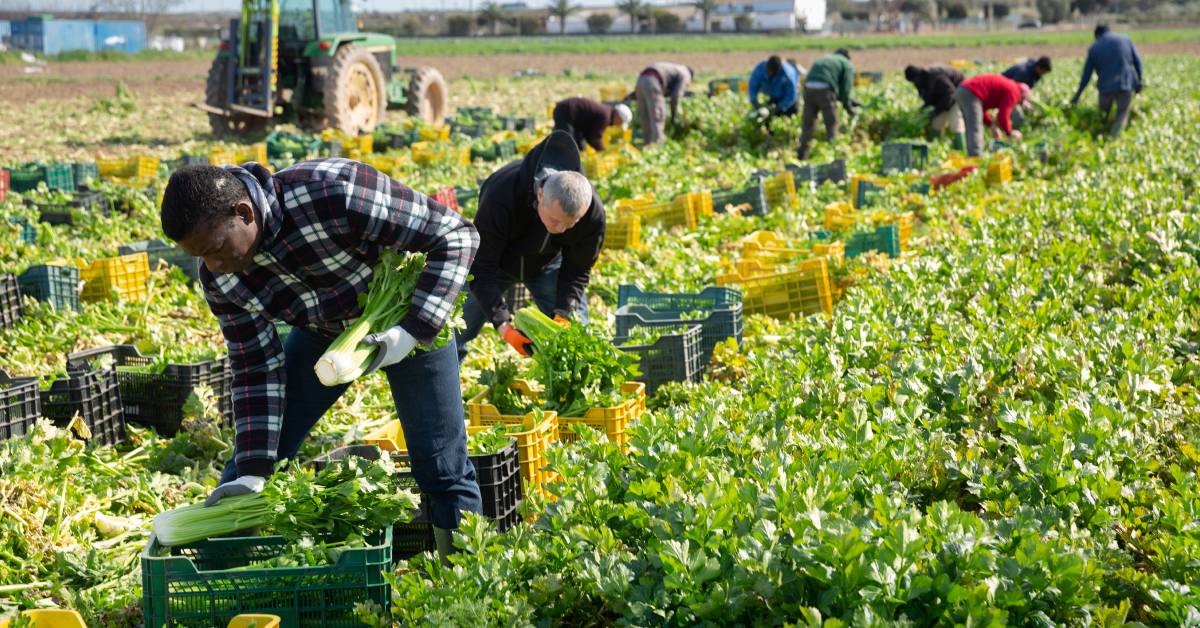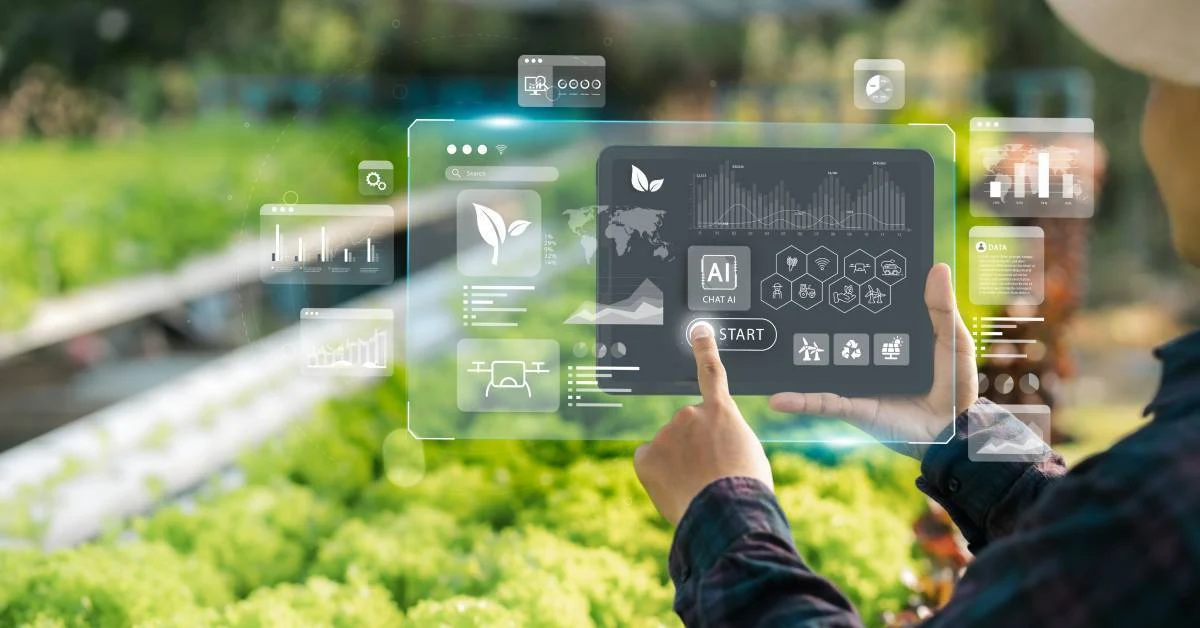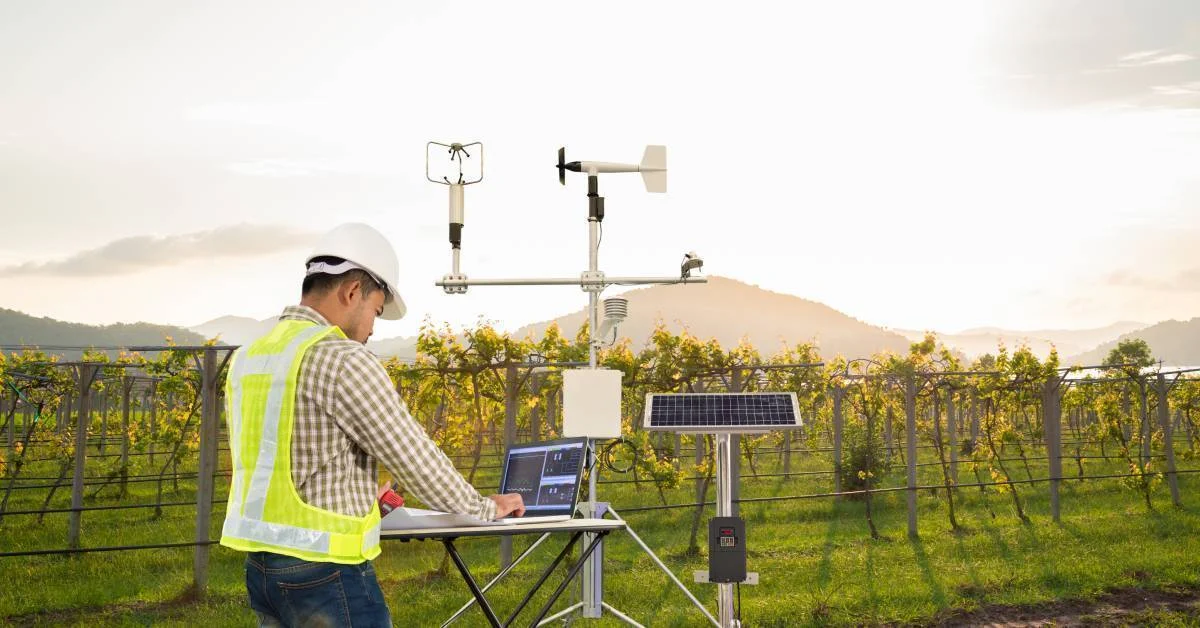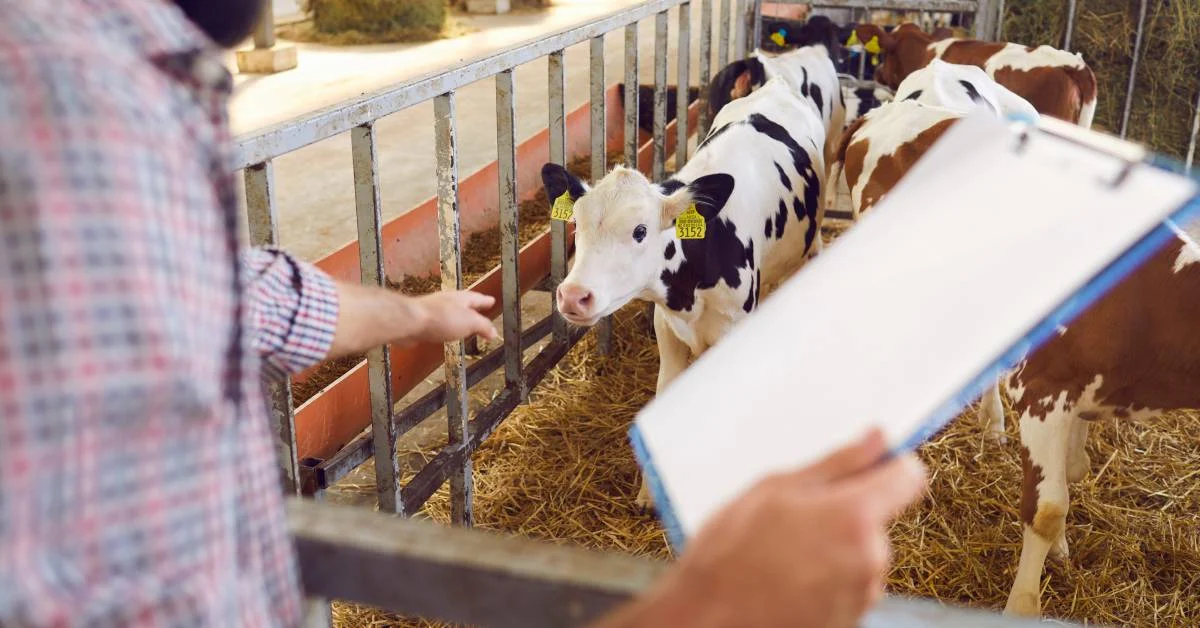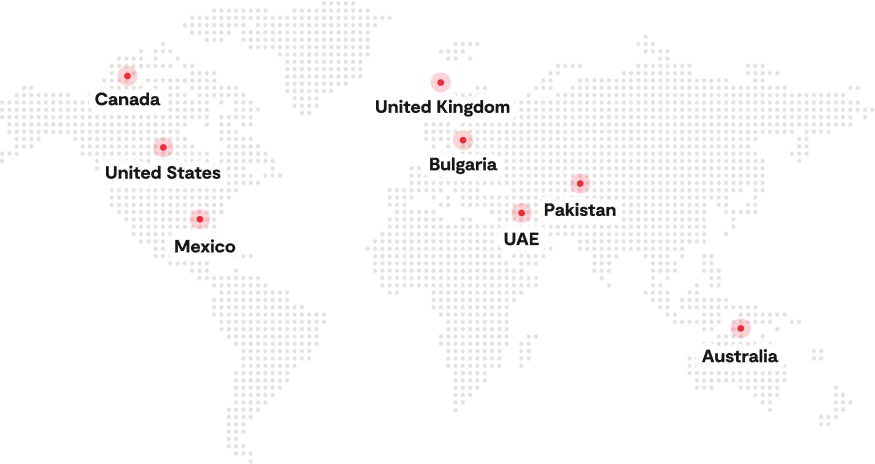Agricultural producers are under growing pressure to meet rising consumer demand while navigating labor shortages, supply chain disruptions, and increasingly stringent food safety regulations. Traditional methods like spreadsheets and manual tracking struggle to keep pace with the real-time demands of today’s global food systems.
As agricultural supply chains become more complex and decentralized, inefficiencies are becoming costlier. The Food and Agriculture Organization estimates that up to 40% of food in developing countries is lost before it ever reaches the market, largely due to a fragmented supply chain. Meanwhile, the agriculture supply chain management market is projected to grow from $20.5 billion in 2024 to over $76 billion by 2035, showcasing a strong CAGR of 12.65% between 2025 and 2035 and reflecting the sector’s urgent shift toward digitization.
Enterprise Resource Planning (ERP) systems have come in as a scalable, integrated solution for modern agribusinesses. By unifying production, inventory, logistics, and compliance workflows in a single platform, ERP technology empowers agricultural enterprises to gain end-to-end visibility, improve decision-making, and reduce operational bottlenecks.
This guide explores how ERP systems are modifying the agriculture supply chain management, offering a practical approach to overcoming the industry’s most persistent challenges.
Why Managing the Agriculture Supply Chain is Complex?
Running an agricultural supply chain isn’t just about moving goods from farm to shelf, but it’s about understanding constant change. From unpredictable weather to short harvest windows and the perishability of fresh produce, the ag supply chain demands real-time visibility and precise coordination across every stage.
What makes it even more complex? Tight margins, compliance pressures, and the need for instant communication between growers, input vendors, processors, logistics providers, and buyers. One delay or miscommunication can disrupt everything, from quality to shelf life to profits.
The stakes are high because nearly 1.3 billion tonnes of food are lost or wasted each year due to breakdowns in the supply chain. For large-scale agribusinesses, solving these inefficiencies isn’t just a matter of profit. It’s essential for long-term sustainability and competitiveness.
The Challenges of Traditional Agriculture Supply Chains
As food production becomes more complex with larger operations, multiple product lines, fluctuating demand, and global distribution, there are more variables to manage across the supply chain. Manual methods like spreadsheets, phone calls, and paper records simply can’t keep up with the speed and precision required.
Here are key challenges holding back traditional agriculture supply chains:
- Lack of Centralized Control Over Critical Tasks: Scheduling harvests, coordinating transport, managing purchase orders, and updating inventory often happen in silos. This manual coordination slows operations and increases the chance of errors.
- Poor Inventory Visibility: Without real-time tracking systems, it’s challenging to monitor input use, harvest volumes, and storage levels across multiple sites, leading to costly shortages or spoilage.
- Inefficient Information Flow Across the Chain: When farmers, suppliers, logistics teams, and retailers operate on disconnected systems, delays in order updates, shipment status, or demand forecasts become inevitable, impacting delivery and sales.
- Limited Quality Control and Traceability: Without digital tracking, it can take days to trace contamination or quality issues, risking consumer safety and non-compliance with regulations.
- Inaccurate Financial Oversight: When data is scattered across departments, calculating the actual cost of crop or livestock production becomes guesswork, undermining profitability analysis and budget planning.
How ERP Improves the Agriculture Supply Chain Management?
Modern agricultural supply chains demand more than manual coordination and siloed systems. ERP platforms provide a unified digital backbone that connects every stage of the supply chain from input sourcing to post-harvest distribution. Here’s how ERP systems help agribusinesses overcome traditional bottlenecks and operate with resilience:
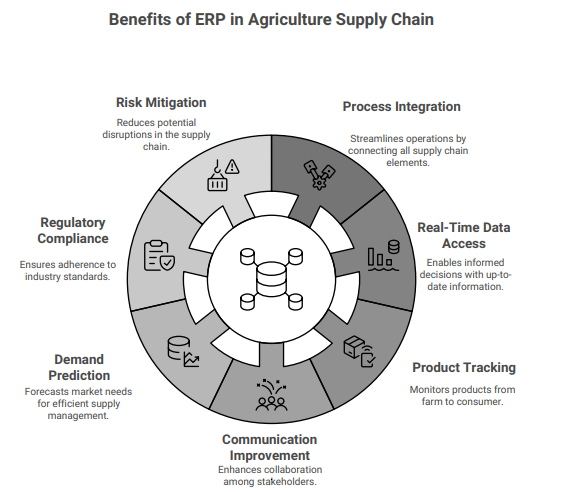
1. Integrating All Supply Chain Processes into One System
ERP systems improve agriculture supply chains by consolidating all core operations, procurement, production, inventory, logistics, sales, and finance into a unified digital platform. This integration replaces disjointed tools and manual processes, allowing for seamless coordination across every node of the supply chain.
A) Connects Field Operations to Back-Office Systems
Modern agricultural ERP solutions bridge the gap between field activities and administrative functions. When planting data is entered, the system automatically adjusts inventory needs, updates equipment maintenance schedules, and refines harvest forecasts. This real-time information flow helps:
- Procurement teams align purchases with actual field demand
- Sales teams access live production forecasts for pricing or contracts
- Finance teams analyze profitability down to specific crops or fields
B) Enables Real-Time Decision Making and Automation
ERP systems integrate with IoT platforms and farm management tools to provide real-time insights that support faster, data-driven decisions. For example, when IoT sensors detect anomalies like equipment issues, temperature spikes during storage, or deviations in crop growth.
The ERP system can automatically update inventory forecasts, adjust procurement plans, or trigger alerts for corrective action. This automation reduces manual intervention, speeds up response times, and ensures key stakeholders are constantly working with up-to-date operational data.
C) Drives System-Wide Visibility and Efficiency
The visibility ERP provides decision-making across the supply chain. Stakeholders no longer work in silos. Instead, they operate on a shared, real-time source of truth.
2. Enhancing Real-Time Data Access for Smarter Decisions
ERP systems improve decision-making in agriculture by delivering real-time visibility across every supply chain function. Instead of relying on outdated records or guesswork, farmers and managers can monitor field conditions, inventory levels, equipment status, and market prices through continuously updated dashboards.
A) Proactive Operations with Integrated Weather & Market Data
When connected with meteorological services, ERP systems alert users to adverse weather conditions ,enabling timely adjustments to planting, harvesting, or logistics. Similarly, real-time commodity price tracking helps farmers act on favorable market conditions by triggering alerts or automating pre-approved sales.
B) Dynamic Inventory & Production Monitoring
ERP eliminates the need for periodic manual stock checks by providing real-time inventory tracking. Warehouse teams can identify shortages in advance, while production teams benefit from sensor-fed insights into seed performance, fertilizer efficiency, and field-level yield variations.
3. Tracking Products from Farm to Fork
Traceability is essential in modern agriculture, protecting consumer trust and meeting regulatory standards. ERP systems unify product tracking across every step of the journey, from farm to harvest to the consumer’s plate.
A) End‑to‑End E‑Traceability
Modern ERP platforms facilitate comprehensive traceability by consolidating data from across the supply chain. They capture and organize key information such as seed sourcing, planting records, field treatments, and irrigation details, creating a unified digital trail for each product.
Input usage, including fertilizer and pesticide applications, is logged along with timing, quantities, and relevant environmental conditions. During harvest, the ERP system helps document quality metrics, field conditions, and processing workflows to ensure end-to-end visibility and compliance.
B) Transparency Across Handling and Distribution
Once harvested, products are tracked throughout packaging and distribution. Each handling event, sorting, packing, and transport is recorded in the ERP, preserving the chain-of-custody and ensuring accountability at every stage.
Solutions like Folio3 AgTech Agriculture Supply Chain Software further enhance this transparency with procurement scheduling and tracking capabilities that automate procurement timelines based on planting schedules and input demands, while also incorporating real-time logistics tracking. This ensures a continuous, traceable flow from input sourcing to final delivery.
C) Enabling Rapid Recall Capability
When safety issues arise, ERP traceability allows companies to identify affected batches and distribution routes within hours, not days, supporting timely recalls and regulatory compliance.
D) Meeting Growing Consumer Expectations
Consumers today expect visibility into food origins, farming practices, and supply chain sustainability. ERP tools can generate detailed product history reports, reinforcing brand credibility and supporting premium pricing models.
4. Improving Communication Across the Supply Chain
Effective communication is vital for aligning operations across geographically dispersed agricultural networks. ERP systems eliminate communication bottlenecks by centralizing updates, streamlining stakeholder collaboration, and ensuring real-time information flow across the supply chain.
A) Automated Notifications for Instant Updates
ERP platforms reduce delays through automated alerts. When harvest schedules or delivery times shift, all relevant parties farm managers, logistics teams, processors, and buyers are notified instantly. This ensures faster decision-making and prevents costly disruptions.
B) Portal Access for Smooth Collaboration
Buyers and suppliers gain secure, role-based access to the ERP system.
- Buyers can track order status, shipment schedules, and quality documentation.
- Suppliers can monitor inventory consumption and receive automatic purchase orders without back-and-forth communication.
C) Mobile Accessibility for Field & Remote Workers
Mobile ERP apps empower field teams and drivers to input and retrieve data on the go.
- Harvest crews can upload quality metrics from the field.
- Drivers can update delivery status in real-time, reducing delays and paperwork.
D) Collaborative Planning Across the Value Chain
ERP tools support shared forecasting, production planning, and logistics coordination. All stakeholders access the same data and contribute insights, improving accuracy and aligning expectations.
E) Centralized Document Management
Contracts, certifications, inspection reports, and regulatory documents are stored in one location. This eliminates confusion over outdated versions and ensures compliance across the supply chain.
5. Predicting Demand and Managing Supply Effectively
Demand forecasting in agriculture is highly complex due to the influence of unpredictable variables like weather, consumer trends, and global market fluctuations. ERP systems with integrated analytics and AI in agriculture capabilities like those in Folio3 AgTech Agriculture Supply Chain Software help manage this process and improve forecast accuracy.
A) ERP Uses Historical & Real-Time Data
ERP systems analyze years of historical data sales records, production cycles, and market demand to identify seasonal trends and recurring patterns. Embedded machine learning algorithms enhance forecasting precision by detecting correlations that manual analysis often overlooks.
B) Incorporates Market & Weather Intelligence
Advanced ERP platforms integrate external data like commodity prices, economic indicators, and weather forecasts. This allows forecasts to reflect external risks or opportunities, such as a heatwave impacting supply or rising demand for specific crops due to shifting dietary trends.
C) Help in Aligning Supply Planning with Forecasts
When a spike in demand is predicted, the ERP system automatically adjusts procurement, production, and inventory management plans to ensure timely availability. This minimizes stockouts, overproduction, and waste.
D) Does Scenario Planning for Resilient Strategy
What if rainfall drops by 30% this season? ERP tools enable scenario modeling to test such variables, helping managers assess best- and worst-case outcomes and prepare accordingly.
6. Ensuring Compliance with Industry Regulations
Compliance is non-negotiable in modern agriculture. ERP systems help businesses stay audit-ready by automating documentation, tracking regulatory updates, and generating reports that meet legal and industry standards.
A) Does Automated Record-Keeping for Food Safety
ERP systems track every stage of the production process crop treatments, harvest dates, equipment use, and test results. This real-time documentation supports traceability and ensures full readiness for food safety audits.
B) Manages Certification and Expiry Management
From organic and GAP to HACCP and SQF, agricultural ERP solutions monitor certification statuses. Built-in alerts notify managers ahead of expiry dates to prevent compliance gaps.
C) Regulatory Reporting Made Easy
ERP systems auto-generate reports in required formats for national and international authorities. This reduces manual effort and eliminates the risk of missing submission deadlines.
D) Helps in Environmental & Sustainability Compliance
Water usage, chemical application, and waste metrics are logged automatically, helping businesses demonstrate compliance with increasingly stringent sustainability regulations.
7. Mitigating Supply Chain Risks
Agricultural operations are vulnerable to risks ranging from extreme weather to supplier failures and financial volatility. ERP systems serve as a centralized risk management tool, helping businesses predict, monitor, and respond to disruptions before they escalate.
A) Supplier Risk Monitoring
ERP systems track supplier performance, delivery reliability, and financial health. Businesses can proactively identify underperforming vendors and maintain backup suppliers to minimize production delays.
B) Weather-Related Risk Management
Integrated meteorological data provides early warnings of droughts, storms, and temperature shifts. ERP systems simulate potential impacts on planting, harvesting, and distribution schedules, allowing teams to adjust operations in advance.
C) Predictive Equipment Maintenance
ERP-enabled maintenance schedules ensure machinery is serviced before breakdowns occur. Predictive analytics flag wear-and-tear issues in critical equipment, reducing downtime during high-demand periods.
D) Financial Risk Mitigation
Fluctuations in commodity prices, currencies, and supplier payment terms are monitored in real time. ERP tools recommend hedging strategies or contract adjustments to protect profit margins and cash flow.
E) Quality Control Assurance
Automated quality checks and threshold-based alerts detect deviations early. This ensures that only compliant, high-quality goods enter the supply chain, preventing recalls and brand damage.
Conclusion
ERP systems are improving the operations of agriculture supply chains by enabling real-time visibility, risk mitigation, traceability, and improved operations. As the industry evolves under pressure to boost productivity and sustainability, ERP adoption is no longer optional, but it’s strategically important.
So, if you want to stay competitive, agri-businesses must invest in integrated tools that scale with their needs. Moreover, explore how Folio3 AgTech ERP can help you future-proof your operations with intelligent, data-driven solutions.
FAQs
What Is Agriculture Supply Chain Management?
Agriculture supply chain management involves coordinating all activities from farm production through final consumer delivery, including procurement, production, storage, processing, transportation, and distribution of agricultural products. It requires managing relationships between farmers, suppliers, processors, distributors, and retailers while ensuring product quality, regulatory compliance, and cost efficiency throughout the network.
What Are the Key Benefits of Using ERP in Agriculture Supply Chain Management?
ERP systems provide real-time visibility across all supply chain activities, integrate fragmented processes into unified workflows, improve communication between stakeholders, enable accurate demand forecasting, automate compliance monitoring, and reduce operational costs through optimized resource allocation. They also enhance traceability capabilities and provide comprehensive risk management tools.
How Does ERP Software Help with Compliance in the Agriculture Industry?
ERP systems automate compliance monitoring by maintaining detailed records of production processes, quality testing, and handling procedures required by food safety regulations. They track certification expiration dates, generate regulatory reports automatically, monitor environmental compliance metrics, and manage international trade documentation, reducing manual effort and compliance risks.
How Does Folio3 AgTech ERP Improve Demand Forecasting for Agricultural Products?
Folio3 AgTech’s ERP solution integrates historical sales data, weather patterns, market intelligence, and seasonal trends to generate accurate demand forecasts. The system uses advanced analytics and machine learning algorithms to identify patterns and automatically adjusts predictions based on changing conditions, enabling better production planning and inventory management decisions.

